![]()
| Tibet, China | Tibet | 2001.10.13 - 10.17 |
Overland to Lhasa
Due to ever-changing Chinese government regulations concerning Tibet, the Nepali-Tibetan border may open or close suddenly. The best way to find the most recent information is to contact Green Hill Tours in Kathmandu by email at ghill@wlink.com.np.
Before we reached Nepal, our friends Kirk and Maren emailed us that tours from Kathmandu to Lhasa could be arranged. We agreed to travel to Tibet together. Numerous agencies in Kathmandu sell Tibet tours. Many are unreliable, providing false information or no information. In our opinion, Green Hill Tours gave the most honest and complete information. Unfortunately, we later discovered that tourists booking with any agent in Kathmandu are handed off to China Tibet Tours, operated by China International Travel Service (CITS), across the border. All tourists are dumped into the same itinerary and accommodation for the first 5 days despite what was sold or promised in Kathmandu.
CITS' level of organization, communication, and issue resolution are appalling. Nevertheless, we reached Lhasa overland and managed to return to Kathmandu by air on tickets mistakenly issued in someone else's names. Disgusted with CITS, we delivered a formal letter of complaint to Green Hill Tours. Still, we were very happy with our decision to go to Tibet.
The standard tour is 8 days: 5 days overland from Kathmandu to Lhasa, 2 full days in Lhasa, and a flight back to Kathmandu on the morning of the 8th day. The cost is about US$350 for the time in Tibet including transportation by 4WD, accommodation, monastery entrance fees, and breakfasts. The flight to Kathmandu is an additional US$260.
Several variations to the standard 8-day package are possible with some negotiation:
The best place to get Chinese Yuan en route is with the freelance moneychangers just after the Nepali-Tibetan border crossing. On the Nepali side of the border, moneychangers gave ¥7 per US$. On the Tibetan side, moneychangers gave ¥8 per US$. By comparison, the Chinese bank rate for cash exchange is US$1 = ¥8.06. See the Tibet Facts for the Visitor page for other exchange options.
We met Ilona who traveled overland from Golmud to Lhasa to Kathmandu. To compare against our tour from Kathmandu, we summarized information received from her.
Adding the expenses, its cheaper to go from Kathmandu to Lhasa and onto Golmud than the reverse. Either direction, the miserable CITS frustrates travelers.
5 DAYS OVERLAND FROM KATHMANDU TO LHASA
Pre-Departure Briefing
Two nights before departure, Green Hill Tours holds a pre-departure
briefing for their clients. This isn't the case with many of the other
Tibet Tour sellers in Kathmandu. During the briefing, Green Hill explains
the itinerary, possible deviations to the schedule depending on the
time taken at Chinese immigration, altitude sickness symptoms, changing
money, and the quality of accommodation. We felt that information
provided by Green Hill was honest and accurate. Some tourists who
booked with other agents were promised luxuries that absolutely don't
exist and were advised to change an outrageously large sum of money
with the money changers at the border. NOTE: we spent the equivalent
of US$15 per person in the 5 days between the border crossing and
Lhasa.
Day 1: Overland to Lhasa
Clients are asked to arrive to the Green Hill Tours office by 06:15
for a 06:30 bus departure. One no-show delayed our departure by 30
minutes. One hour into the journey, the bus stopped for breakfast,
the cost of which was included in the tour price. 3 additional hours
of driving up paved roads through small villages and uncountable checkpoints
brought us to a final stretch of rough dirt road that led to the border
town of Kodari. Green Hill collected our passports to complete an
hour-long Nepal exit immigration process. During this hour, Nepali
moneychangers hound tourists, offering poor rates of ¥7 per US$.
They wouldn't give ¥8 per US$, the rate offered just over the
border. With our passports returned, a 15 minute walk over a wide
bridge took us to a Chinese banner proclaiming our entry into China.
A lone soldier sat at a desk at the banner with a list of names approved
for entry into Tibet. He crosschecked the name on our passport with
the names on the list. Due to a clerical error, one of our party's
names didn't appear. He was held between Nepal and China for about
4 hours until Green Hill rectified the mistake. Entering Tibet moves
the clock ahead of 2 hours 15 minutes. All of China is on Beijing
time.
Beyond the Tibet Permit checkpoint are moneychangers offering ¥8 per US$ and a line a stalls selling blankets and clothes. At this point, we were loaded into the back of a truck to carry us up a very rough dirt road 12km to the border town of Zhangmu where Chinese immigration can take hours. Here we spent the night at 2300 meters.
Day 2: Overland to Lhasa
In the morning, the 16 Green Hill clients were combined with all other
Kathmandu agency clients. Our group ballooned to 44 clients, 9 drivers,
and 1 inept guide. We were told to be ready for departure at 09:00. For
some reason undisclosed to the group, we were delayed until 11:00. 5
clients made a 4WD grouping. We immediately formed a group of 4 with
Kirk and Maren. Just before departure, an Australian named Mike was
added to our group to complete the car. Off we drove with a driver who
spoke no English and a guide in the lead car who thought it too much
trouble to introduce himself to his clients.
The road stayed rough but the scenery was gorgeous. Steep green mountains with magnificent waterfalls and perched pagodas reminded us of Chinese paintings. As we ascended past 4500 meters, the landscape became more arid. Rivers continued to flow from melting glaciers 7000 and 8000 meters high but the climate could sustain little vegetation. Crossing Lalungla Pass at 5050 meters, we had views of Mt. Xixapangma, the highest mountain in Tibet at 8013 meters and several 8000+ meter peaks in Nepal including Mt. Everest (8848 meters). Though the view from the pass was fabulous, it was too much elevation gain in a single day for most clients. Even having descended to 4300 meters for an overnight in Tingri, we were both sick along with a majority of the other 42 clients.
Day 3: Overland to Lhasa
The water puddles in Tingri were frozen at our wakeup time of 06:00.
Masami was throwing up and in no mood for breakfast. Wes wasn't feeling
much better.
The drive was long and dusty, crossing arid land ranging in elevation between 3900~5220 meters. Occasional Tibetans walked by with their yaks. Small towns with dirt buildings spotted the landscape dozens of kilometers apart from each other. People tilled frozen fields that didn't appear to bear anything. Others sat around tents of stitched burlap with gaping holes in the frozen 4800 meter desolate climate. 10 hours of continuous driving at 30km/h finally brought us to Xigatse, Tibet's second largest city. After checking in to a hotel without running water, we found a public bathhouse in town and enjoyed our first clean, hot shower in Tibet.
Day 4: Overland to Lhasa
We viewed our first monastery in Xigatse. Tashilumpo Monastery, built in
1447, was the winter residence of the Panchen Lama. Being our first
Tibetan Monastery visit, we found everything fascinating from the
construction to the colorful exteriors, gold-topped roofs, giant Buddhas,
silk tapestries, and wall paintings. Exterior colors always include
white for compassion, red for wisdom, and black for protection.
Admission is ¥55 and inside photo-taking costs an additional
¥15~¥75 depending on the building.
After a visit to Tashilumpo, our driver took us to the Xigatse Bazaar. Outdoor stands sold goat meat, jewelry, and fruit. Masami found an "eye" bead (called "Zie") that she learned about in Singapore. Costs in Singapore ranged between US$100-$1000s. Masami found one she liked in Xigatse with a starting price of US$62 and a post-negotiation sale price of US$35.
At 14:00, the group departed for Gyantse, 90km away. 4 hours later after charging through incompletely constructed roads, sliding down sandy banks to bypass dirt-mount-roadblocks, and generally improvising the route up the Nyang Chu River valley, we finally reached our destination. A final stop at Kumbum Chorten Monastery with a beautifully maintained stupa completed our day. It was at Kumbum in 1938 where the 14th Dalai Lama stayed at age 3 en route to Lhasa after having been identified as the reincarnate of the 13th Dalai Lama.
Day 5: Overland to Lhasa
An 8-hour continuous drive through dusty highland crossed more villages
in the seemingly inhabitable environment. We descended the arid
mountains into a lush valley with paved roads. 2 hours later we
entered Lhasa.
This 5-day overland trip was bumpy, dusty, and wearing, but we appreciated the chance to see the Tibetan landscape. Any route, including flying, to Lhasa is difficult and makes most people sick from altitude gain. We can recommend the route we took from Kathmandu.
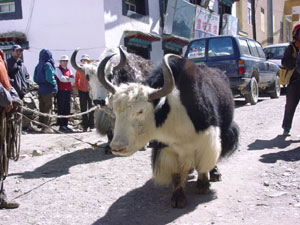 |
A man walks his yaks through Latse, Tibet's old capital. Yaks are only found at high altitude. At lower altitudes they lose their ability to reproduce. |
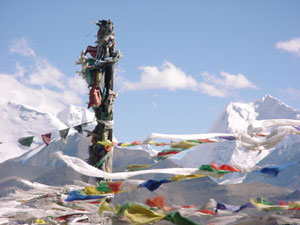 |
From Lalungla Pass at 5050 meters / 16,568 feet, we could see Mt. Xixapangma, Mt. Makalu, Mt. Lhotse, Mt. Cho Oyu, and Mt. Everest. |
 |
Luckily, the sky was clear when we drove by Mt. Everest. |
 |
Between Xigatse and Gyantse, a large dirt pile in the middle of the one-lane dirt road forced our caravan of 4WDs to detour down a steep sandy bank. Since the roads are constructed little by little using manual labor, different detours are required every week. |
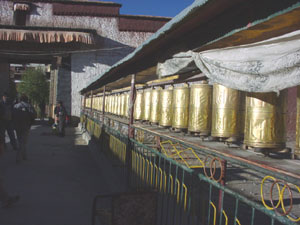 |
Prayer wheels line the entrance to Kumbum Chorten in Gyantse. |
 |
The stupa at Kumbum Chorten is well maintained. Tiny unlit chapels housing gods and protectors circle the diameter of every level of the stupa. Visitors circle clockwise and climb internal steps to the next level until they reach the top. |
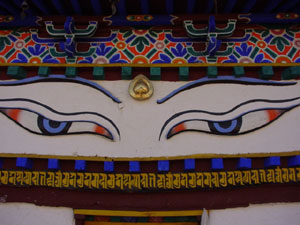 |
Eyes at the top level of the Kumbum Chorten stupa watch in every direction. |
 |
A monk walks to town outside the Tashilumpo Monastery in Xigatse. |
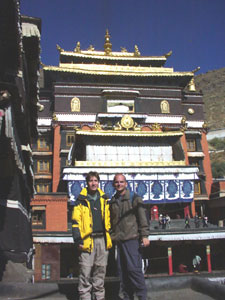 |
Wes and Kirk stand outside the main prayer hall in Tashilumpo Monastery in Xigatse. |
Copyright © 2000-2002 Wes and Masami Heiser. All rights reserved.